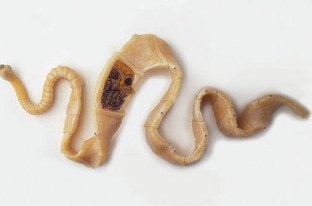Parasitic infections are a large group of diseases, pathogens which are microorganisms of the class protozoa and helminths (worms). To date, there are over 200 species of parasites, of which 70 species are found in the European countries and Russia.
Parasites penetrated into the human body, develop and exist due to the "exploitation" of the resources of the body instead of poisoning it with their waste products and causing dysfunction of numerous organs and systems.
In the first stage of development of helminth infection diagnosis of the disease is not feasible, because one still does not feel the presence of parasites and his condition is satisfactory.

Even after some time, people still experience discomfort from the presence of parasites in the body, only can sometimes experience some minor problems with some organs and systems. In this case, the important factor is careful attention to their health. Even a slight ailment may be the first alarming signal about the development of the illness starts.
Most often the infection is diagnosed accidentally, the result of a routine medical examination or when the person has already sought medical care as a result of rapidly deteriorating General condition.
Classification of parasites
All parasites are divided into:
- protozoa (Giardia, Toxoplasma gondii, Entamoeba histolytica);
- worms (pinworm, roundworm, Toxocara)
Helminths are a diverse group of parasites, which is characterized by different life cycles, biological characteristics, distribution within the body and specific development in him. So klassificeret of worms on different principles: structure, life cycle, depending on the location of parasites and the duration of interaction with the host organism.
Biological principles are distinguished:
- Bio-helminths (bovine and pork tapeworm, Echinococcus, opisthorchis). The life cycle of these parasites should be carried out in two or even three intermediate hosts, i.e. other living organisms.
- Geo-helminths (Ascaris, whipworm, Ancylostoma). In the course of its development does not require the change of the owner, they are excreted together with feces in the environment and are localized in the soil, and at a certain temperature and humidity in eggs and developing larvae. Eggs containing live larvae enter the body and takes the next step of their development.
- Pin worms (pinworm, dwarf tapeworm) these parasites stand out in the environment together with feces, and the lack of personal hygiene, is an infection oral-fecal route, it is the eggs of these parasites person swallows. The main source of infection is dirty hands.
The structure of helminths are divided into:
- nematode or round worms (pinworm, roundworm,vlasoglavy);
- trematodes or flukes (Schistosoma, opisthorchis, cat and Siberian Fluke);
- cestodes or tapeworms (Echinococcus, bovine and pork tapeworm).
At the location in the organism are distinguished:
- intestinal worms (pinworms, roundworm, bovine and pork tapeworm);
- outside-intestinal (alveolar, opisthorchiasis, the species Trichinella).
Ways of infection with parasites
There are various ways of Contracting worms:
- The eating of meat dishes, which is not subjected to quality heat treatment, meat can contain parasites, which are tightly fixed in the muscles of large and small cattle, eating the meat of infected people, swine and bovine tapeworm, Echinococcus.
- Consumption of salted, smoked, little-solo and raw fish. In raw fish are opisthorchis and a tapeworm, because the life cycle of these parasites involves changing several owners, one of which is fish.
- The use of raw water from unknown sources, washing dishes, vegetables and fruits in the water, for example, on vacation.
- When working in the garden without protective gloves geo-helminths can get on hands, and hands to mouth. You can also get infected by this type of parasites through the dirty vegetables, herbs and berries.
- Through contact with pet. Domestic dogs and cats are carriers of many parasites. Especially do not allow Pets to sleep in the same bed with people or allow them to lick the hands and face of a person.
- The source of infection people can become infected with an acute form of helminthiasis.
The symptoms of worms in adult

Signs of worms in humans occur already at a late stage of infection. Of course, some of the signals the body gives at the very beginning of the disease, it's time to pay attention to them and interpreted correctly. At the very first stages of the penetration of parasites in the human body may experience minor symptoms, which can be taken as a result of other diseases:
- fatigue;
- frequent headaches;
- increasing weakness;
- irritability;
- sleep disturbance;
- weight loss for no apparent reason;
- apathy and depression.
The next stage of development of the helminth infection, there is a General Allergy of the body. On the skin of the patient appear different kinds of eruptions, and clinical blood tests reveal an increase in eosinophils, indicating the development of allergic reactions.
When the parasite develops into an adult and is localized in a particular organ, the symptoms appear, characteristic for the presence of parasites. Most often, the worms are placed in a thin or large intestine, therefore, experience symptoms characteristic for diseases of the gastrointestinal tract in the form of dyspepsia (fermentative and putrefactive phenomena):
- pain in the navel;
- loss or poor appetite;
- in some cases, increased appetite;
- flatulence; rumbling and gurgling in the abdomen;
- constipation and diarrhea;
- vomiting and diarrhea;
- bloating.
Next is the development of anemia and vitamin a deficiency, because the person lacks nutrients that intercept parasites. In this case, the person feels:
- chronic fatigue;
- dizziness;
- increasing weakness;
- headaches.
In severe advanced cases, observed the development of serious diseases that require urgent treatment:
- allergic myocarditis;
- meningoencephalitis;
- pneumonia;
- hepatitis or disorders of hemostasis;
- hematuria (blood in urine);
- the decrease in the protective forces of the body (malfunction of the immune system);
- disruption in the endocrine system;
- lymph nodes.
The decrease in the protective forces of the body increases the likelihood of developing viral and bacterial infections. But in children, the parasites provoke the delayed physical growth and mental development. Symptoms of worms in humans are common, however, different types of parasites and their localization in the body contributes to the development of characteristic symptoms from the affected organs.

The clinical picture in invasion of different species of parasites
Depending on the helminth living in the body, the symptoms can be very diverse.
For example, when enterobiasis the most important symptoms are:
- itching in the anus;
- pain in the abdomen;
- wolverina girls in contact with parasites on the vaginal mucosa.
The initial phase of ascariasis, which is called migration, is manifested in the form of:
- pulmonary diseases: bronchitis, laryngitis or tracheitis.
Intestinal form of ascariasis observed:
- nausea and vomiting;
- abdominal pain;
- decrease of appetite;
- the lesions on the skin;
- increase of eosinophils in the blood.
In severe advanced cases, observed:
- violation of the integrity of the intestinal wall;
- with the subsequent development of peritonitis and appendicitis (in contact with Ascaris in the Appendix);
- liver;
- bowel obstruction (blockage in the bowel lumen).
During infection of the cestode (tapeworms) in the process of defecation along with stool stand out part of the parasite. In this scenario, you experience the following symptoms:
- nausea and vomiting;
- increasing weakness;
- dizziness and headaches;
- constipation and diarrhea;
- abdominal pain;
- the decrease in body mass.
With the progression of the disease there is severe anemia that is caused by lack of vitamin b 12 and iron.
Opisthorchis his presence in the body can cause serious lesions of the bile ducts of the liver, gallbladder and ducts of the pancreas. Since the presence of parasites in these organs, creating an obstacle to the outflow of bile, developing cholecystitis, biliary dyskinesia, pancreatitis. Inflammatory processes in these organs accompanied by a rise in temperature, heaviness in the right hypochondrium, pain in region of gall bladder (biliary colic), nausea and vomiting and diarrhea. The presence of Trichinella in the body causes severe damage of muscles: intercostal, chewing, muscles of the tongue, pharynx, eyes, diaphragm.
Hookworm, vlasoglavy, shistosoma, a tapeworm in the body cause anemia, intestinal dysbiosis, deficiency, metabolic disorders. And in the urine-sexual schistosomiasis appears this symptom is urinating with blood.
When alveococcosis, echinococcosis, cysticercosis initial stage is almost asymptomatic, but when the acute stage of the development going on to suppuration and rupture of small cysts with parasites, which leads to very serious consequences:
- the peritonitis;
- pleurisy;
- anaphylactic shock;
- damage to the blood vessels and chronic bleeding from them (hookworm feed on blood);
- the Central nervous system.
Roundworms Strongyloides provoke the development of allergic reactions, pathology of the biliary tract and disorders in the digestive tract.

A test by which to determine the presence of parasites in the body
With this test we can detect the presence of parasites in the body. For this you just have to answer the following questions:
- Have you itching in the anus?
- Are there any skin rash?
- Do you feel nausea?
- Is there vomiting?
- If there is insomnia?
- Is there a bitter taste in your mouth? And how often?
- Enlarged lymph nodes?
- How often have muscle pain? What is their intensity?
- Is there a loss of body weight?
- Is there loss of appetite?
- If symptoms such as tiredness, fatigue, reduced concentration and efficiency?
If the received 10 positive responses, we can assume the presence of helminth infection with a high degree of probability. All these symptoms observed in the acute stage of the disease. Because in this period the worms are most active and have a significant impact on the body.
Prevention of anti-worm infestations
Prevention of helminthiasis primarily boils down to personal hygiene:
- washing your hands often;
- frequent change of underwear and bed linen;
- timely and qualitative cleaning of premises;
- the use of individual household items: towels, utensils, etc.;
- timely deworming of domestic animals;
- quality heat treatment of meat products and fish;
- the rejection of the use of raw fish, gently eat salted, dried, smoked and a little salt fish;
- all garden work protective gloves;
- use only clean water for drinking;
- do not swim in unknown waters.
- to carry out drug prevention of helminthiasis twice a year: in spring and autumn.

































